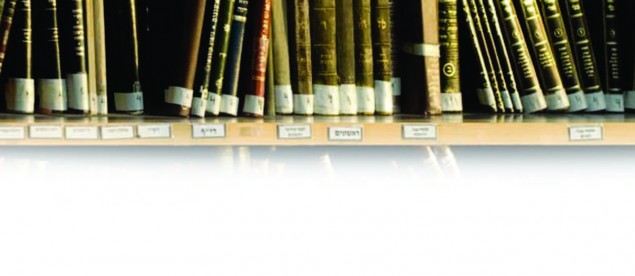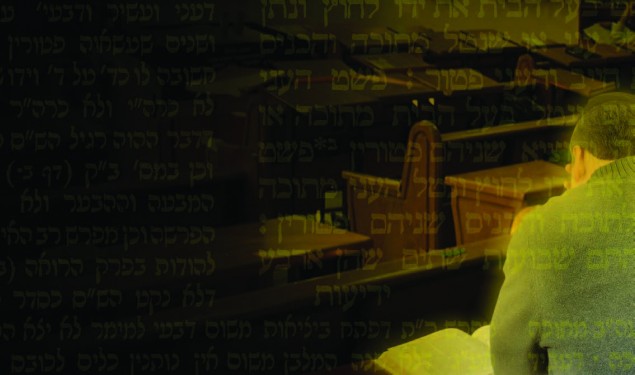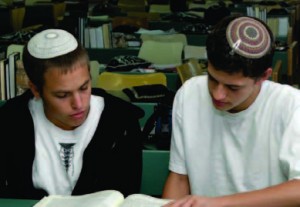Gemara and the Ba’al Teshuvah
“Why learn Gemara?” is a question most ba’alei teshuvah will ask themselves in the course of their Torah study. It is rather unlikely that Gemara inspired the ba’al teshuvah to take his initial step towards Torah. He was probably attracted to Torah by the beauty of its ideas about life, purpose, self-knowledge and relationships. Having decided to put his life on hold to learn more Torah, he now finds himself in front of a large, intimidating volume comprised of two foreign languages, with discussions on obscure details of various laws that he is likely never to encounter. And there he sits, somewhat bemused, wondering, “Why this is so important?”
Although a great deal of appreciation for learning Gemara comes from actually doing it–ta’amu ure’u–and for this there is no substitute, nonetheless a good orientation is certainly required. The Torah is Hashem’s will, and the process of elucidating His words connects us to Him, irrespective of the particular subject in question. In addition, it should be stressed that every area of Torah is impacted by one’s inability to learn Gemara.
Rashi is the most basic commentator on Chumash. Yet many Rashis flow like a Gemara–and many more are direct quotations from the Gemara. These Rashis may well remain inaccessible if one has not acquired the ability to analyze a gemara.Moreover, any given biur halachah (elaboration of a halachah) on the most relevant halachic topic can often read like a Tosafot; such a work too would be off limits to one unfamiliar with Gemara methodology. This is certainly the case with regard to the “new” halachic questions that are so prevalent due to technological advances and societal changes. In general, the newer the question, the “older” the answer will be, as one needs to explore the roots of the particular sugya (topic) as found in the Gemara, to deal with cases that the Shulchan Aruch didn’t address.
In the realm of Jewish thought, Gemara is also significant as it contains much machshavah (Jewish thought or theology), the full impact of which is only gleaned if one is sensitive to the nuances of diukim (deductions) and hava amina (original suppositions) upon which the Gemara discussion is based. To this end, it is worth demonstrating once in a while how the principles in the sugya have bearing on everyday life, e.g., the concepts of kinyan chatzer (acquiring something when it enters your domain) and keilav shel lokeach (a vessel that belongs to the one who wants to possess it) as they would relate to loose change found in a soda machine, et cetera.
Having decided to put his life on hold to learn more Torah, the ba’al teshuvah now finds himself in front of an intimidating volume comprised of two foreign languages, with discussions on obscure details of various laws that he is likely never to encounter.
This leads to another question: How much of the ba’al teshuvah’s yeshivah day should be devoted to Gemara? The answer would seem to depend on how long the student has been exposed to learning. The yeshivah where I teach–Machon Yaakov in the Har Nof section of Jerusalem, under the leadership of Rabbi Beryl Gershenfeld–consists of a two-year program. In the first year, although emphasis is placed on introducing students to the study of Gemara, it is within the context of a well-rounded curriculum of Torah subjects, e.g., Chumash, halachah, hashkafah, et cetera. The second-year program focuses significantly more on Gemara, with most of the day devoted to iyun (analysis) and bekiyut (widespread knowledge) although there are still slots for other Torah subjects as well.
A major obstacle for the newcomer to Gemara is vocabulary. The student may still be struggling with basic Hebrew, and now he is now confronted with Aramaic! For a young adult with an analytical mind, it can be especially frustrating to be unable to read more than a few words. There are no quick solutions to developing a Gemara vocabulary. Many teachers use vocabulary sheets that may be very useful for making the sugya at hand more digestible, but they rarely yield enduring gains. A wonderful idea that has been used quite successfully is to have the student write his own “dictionary.” Every day, he should choose three words that he judges to be “key words” that he expects to see again. Key words are then reviewed on a weekly basis, either with a chavruta or with the rebbe, and within a few weeks the student will have the beginnings of a working Gemara vocabulary. In addition, the student should be trained to try and look for the root of a word, as this will allow him in many instances to attain a “family” of words at one time. The rebbe should also try to show how certain words are related to terms found in the Chumash or siddur. The rebbe needs to balance the need to develop the student’s textual skills–which, although demanding time and effort, is arguably the talmid’s greatest asset when he leaves the yeshivah–with ba’al peh, oral discussion, in which the student will be able to participate more freely as he learns the vocabulary.
 Another challenge the student encounters is on an intellectual plane. Although he may be bright and capable of engaging in an analysis of the concepts he is learning, he may still find it difficult to follow the long chains of discussion often found in a sugya, especially as he needs to keep track of what was held true at each stage of the discussion. In addition, he may be used to contemplating one idea at a time, whereas when studying Gemara there are often multiple opinions or approaches “on the stove” simultaneously. Brief summaries every once in a while are very helpful for consolidating the flow of information. Many rebbeim also use charts and diagrams to help organize the information.
Another challenge the student encounters is on an intellectual plane. Although he may be bright and capable of engaging in an analysis of the concepts he is learning, he may still find it difficult to follow the long chains of discussion often found in a sugya, especially as he needs to keep track of what was held true at each stage of the discussion. In addition, he may be used to contemplating one idea at a time, whereas when studying Gemara there are often multiple opinions or approaches “on the stove” simultaneously. Brief summaries every once in a while are very helpful for consolidating the flow of information. Many rebbeim also use charts and diagrams to help organize the information.
It is also helpful when concluding a topic to ask the students to stop, organize the sugya in their own minds and then have one student summarize it for the class. When a student has to express the elements of the sugya in his own words, it helps him digest it. Because of the students’ greater aptitude for conceptual discussion–and because it is less demanding technically–they will often tend towards it; and although it is a crucial part of the shiur, the rebbe has to see that the lamdut (the theory) is integrated with the give-and-take of the Gemara. Otherwise the talmidim may have an enjoyable and stimulating discussion, but may leave the shiur knowing no more Gemara than when they came in.
It is also important to note that the ba’al teshuvah can frequently encounter considerable disparity between his own ideas and those of the Gemara. It is essential not to repress his ideas, but allow him to articulate them while he slowly disavows some of his basic convictions. It takes time to realize that much of what he considers to be universal truths are in fact the conventions of a particular place and time.
Nonetheless, success in Gemara learning is not that the talmid convince himself that he never opposed what the Gemara is saying. On the contrary, once a student has expressed that he would have looked at things differently, he will probably find it easier to accept the Gemara’s view. Otherwise, the two conflicting ideas may remain gridlocked in his brain, causing confusion and frustration. The most vigorous and meaningful Gemara discussions take place when the talmid fully participates with all his intellectual and emotional faculties.
Another way to make the Gemara experience more meaningful is for the rebbe to devote a few minutes to introducing each new commentator. It is often helpful to provide historical context and perhaps even an anecdote about a particular commentator. All of this goes a long way in personalizing the various Gemara commentators to students who often feel like they are in an asteroid belt, constantly being bombarded with names of rabbis who are indistinguishable one from the other. It makes a tremendous difference to have even a basic appreciation of “who’s who” in the Torah world. Needless to say, these “extras” cannot dominate the shiur; like spice, they can add flavor, but they do not constitute a meal. A comprehensive survey of some of the Rishonim and Acharonim should be the topic of a separate shiur.
My rosh yeshivah, Rabbi Baruch Mordechai Ezrachi, once said that seeing success is the most important thing for someone learning Gemara. This is certainly true for a ba’al teshuvah. Although he may not be able to fully prepare the Gemara by himself yet, a sense of success can be felt most during chazarah (review) period; most of the groundbreaking work has already been done, and the review period allows the student to intellectually incorporate the material. This is especially important with regard to another significant barrier: Because of the lack of punctuation in the Gemara, it is difficult at first to know where one is in the flow of the discussion. Is the Gemara giving an answer, or has it not yet finished asking the question? Is the next source a proof for the above, or a challenge to it? It is through chazarah that one begins to assimilate a sense of the “topography” of the Gemara and to feel comfortable with its style. The benefits of the chazarah period should be stressed to the student, as it will give added meaning to what may otherwise be seen as merely reviewing material that he already knows. Some form of testing– whether oral or written–can also serve to show the talmid that he is progressing, as well as making him feel accountable for his learning. Additionally, many students find that having to prepare and present a shiur to their peers is a very energizing experience. Students have told me that the hours they spent preparing for a shiur were among their most intense and rewarding times spent learning.
In reality, many talmidim struggle with even the basic give-and-take of the Gemara. It is important for them to feel that mastering the basic peshat (literal understanding) is a worthy goal–which it is! Appreciation for what they are doing is more likely to encourage them toward higher achievements. Along with all of this, the shiur should be enjoyable! The geshmak (enjoyment) of mastering the Gemara is what will keep the talmid inspired and encouraged as he develops his technical skills as he hopefully forges a kesher with the Torah that will remain vibrant and dear to him wherever he goes.
Rabbi Immanuel Bernstein teaches at Machon Yaakov in Har Nof, Jerusalem and at Michlalah Jerusalem College. He is the author of Devar Mikra, a commentary on Chumash and Bircas Yitzchak, a collection of novellae on Gemara.


